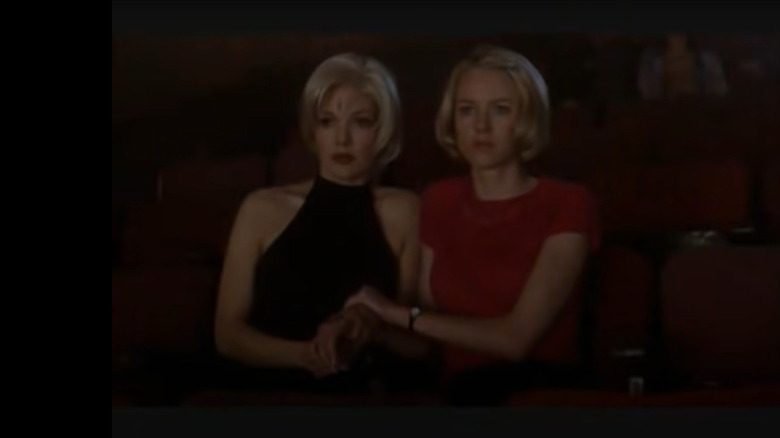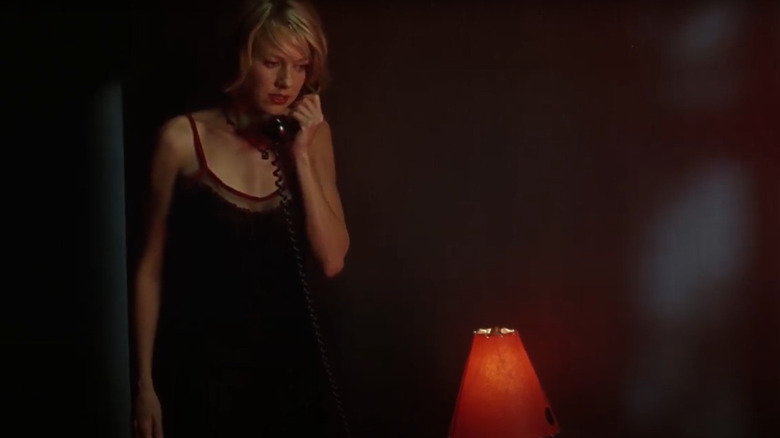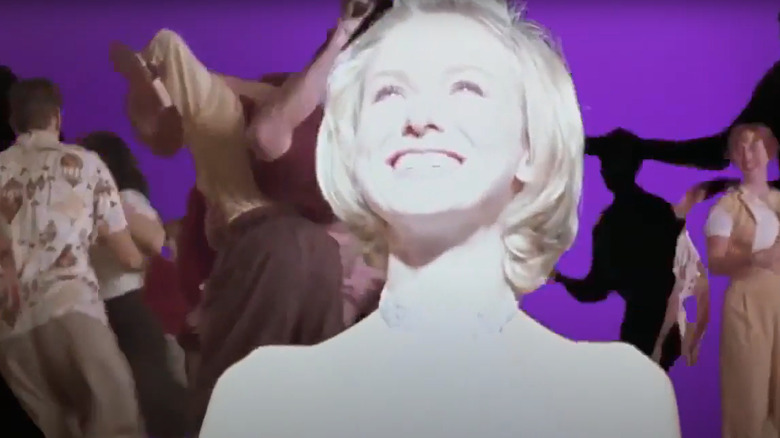The Big Clue Everyone Missed Early In Mulholland Drive
Not many filmmakers get their own adjective. But the term '"Lynchian" immediately conjures up connotations of mystery, absurdism, dream logic, horror, eroticism, and apple-pie Americana. Writer-director David Lynch is an unmistakable voice in cinema that some call visionary ... or just plain weird. His films have intoxicated, baffled, and often infuriated audiences since his 1977 experimental film debut "Eraserhead." It's telling that "Dune," the one film Lynch disowned because studio interference made him "sell out" his vision, is still indelibly Lynchian.
Much of Lynch's output, including "Blue Velvet," "Twin Peaks: Fire Walk With Me," "Lost Highway," and "Inland Empire" frequently borders on pure surrealism, with images, atmospheres, and situations seemingly erupting from the unconscious and not amenable to rational explanations. The director himself is famously enigmatic when asked to spell out the meanings behind his work. In his book "Catching the Big Fish," Lynch explained, "The world in the film is a created one ... I think it's so precious and important to maintain that world and not say certain things that could break the experience."
2001's "Mulholland Drive" is considered by many to be the zenith of Lynch's filmography, earning him a best director Oscar nomination in 2002 and a best director win at the 2001 Cannes Film Festival (via IMDb). In a 2015 BBC Culture poll, it was voted "the 21st Century's greatest film." It also has several carefully hidden clues that could help viewers figure out its meaning, including one that played out early in the film.
Mulholland Drive plays out like a dream
Perhaps more than any other Lynch film, "Mulholland Drive" could be described as "dream-like." Backed by Angelo Badalamenti's haunting score, the movie frequently blurs the borders between fantasy and reality; with seemingly unrelated narrative digressions, ominous appearances by unsettling figures like a cowboy with no eyebrows and a filthy hobo who scares people to death, and a network of unexplained symbols.
For the first two-thirds of the film, "Mulholland Drive" actually has a fairly straightforward plot structure. Wholesome mid-westerner Betty Elms (Naomi Watts) arrives in Hollywood with dreams of stardom. She meets the beautiful and mysterious amnesiac "Rita" (Laura Harring), whom she invites to stay with her while the pair embarks on an adventure to solve the riddle of Rita's true identity. Meanwhile, Betty goes to movie auditions but, unbeknownst to her, corrupt mafia bosses control casting decisions from the shadows. Betty and Rita fall in love, discover the corpse of a woman named Diane Selwyn in a shabby apartment, then make a nocturnal visit to the sinister Club Silencio.
That's when things take a shocking turn for a horrific final act that leaves many viewers scratching their heads. Betty, it seems, is not Betty but Diane Selwyn. Rita is actually Camilla Rhodes, Diane's lover and rival actress. Diane hires a hitman to kill Camilla out of professional and romantic jealousy. Other faces from the first part of the movie reappear as different characters. In the terrifying climax, Diane, acting out of despair and guilt for what she's done, dies by suicide.
As it happens, the very fact that "Mulholland Drive" plays out like a dream could be a major key to its meaning, and in 2002, Lynch shared 10 clues to help attentive audiences unlock the film's secrets.
David Lynch's 10 clues for decoding Mulholland Drive
When the "Mulholland Drive" DVD was released in 2002, despite refusing to include chapter breaks because they "demystify" the experience, Lynch took the unprecedented step of including a liner insert listing 10 clues to deciphering the film's meaning.
1. Pay particular attention to the beginning of the film: two clues are revealed before the opening credits.
2. Notice appearances of the red lampshade.
3. Can you hear the title of the film that Adam Kesher is auditioning actresses for? Is it mentioned again?
4. An accident is a terrible event... notice the location of the accident.
5. Who gives a key, and why?
6. Notice the robe, the ashtray, the coffee cup.
7. What is felt, realized and gathered at the club Silencio?
8. Did talent alone help Camilla?
9. Note the occurrences surrounding the man behind Winkies.
10. Where is Aunt Ruth?
Given Lynch's notorious resistance to explanations for his films' meanings, some have suggested his list represents a giant red herring. But as Lynch made clear in an interview shortly after the film's release, compared to some of his more abstract trips such as "Lost Highway," "Mulholland Drive" has a perfectly logical story that can be unwrapped and decoded if you pay attention.
A widely-accepted theory about the structure of "Mulholland Drive" is that the final third of the film, in which Naomi Watts plays the desperate, betrayed, and disintegrating actress Diane Selwyn, is, in fact, the reality. The preceding "Betty" story was all a feverish wish-fulfillment hallucination that Diane experiences following her guilt-ridden breakdown after having her lover Camilla murdered. Of all Lynch's clues, it's the first one that most clearly indicates Betty's story was Diane's fantasy.
The pre-credit sequence tells us Diane Selwyn was dreaming
The film opens with a montage of couples dancing the jitterbug. The scene later fades to an extreme close-up of red sheets and a pillow as the camera slowly plunges toward the bed, as if from the point of view of someone passing out. It's an opening that, on first viewing, is easily forgotten. But, representative of the film as a whole, it becomes more significant.
In the film's final act, Diane Selwyn confides that she made her ambitious trip to Hollywood on the back of winning a jitterbug contest back home. The red bedclothes are seen again later in the film — it's the bed on which Betty and Rita discover Diane's corpse. As such, we have a clear indication that this is Diane's story. It opens with the jitterbug contest that sent her to Hollywood, followed by her collapse onto the bed in her crumby apartment as she sinks into the fever-dream in which she becomes Betty, the wholesome, talented, and beloved up-and-coming starlet. In the end, Diane's fantasy is over and she's faced with reality so crushing that she takes her own life.
Is this the single "true meaning" of "Mulholland Drive?" Does it explain all the film's labyrinthine mysteries, symbols, secrets, abstractions, and loose ends? Almost certainly not. The film invites viewers to impose their own interpretation on each new viewing; does anybody have a single proprietorial grasp over its meaning, even Lynch himself? Probably not.



